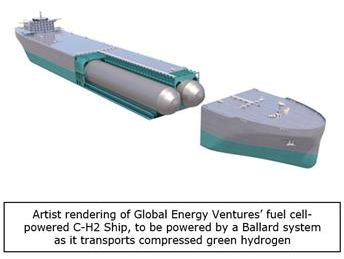VANCOUVER, CANADA and WEST PERTH, AUSTRALIA – Ballard Power Systems (NASDAQ: BLDP; TSX: BLDP) today announced that it has signed a non-binding Memorandum of Understanding (MOU) with Global Energy Ventures (ASX: GEV; www.gev.com) – a provider of integrated compressed shipping solutions for the transportation of energy to regional markets, headquartered in Australia – for the development of a new fuel cell-powered ship, called C-H2 Ship, designed to transport compressed green hydrogen.

The power required for a small-scale demonstration of the C-H2 Ship is expected to be under 10 megawatts (MW). At full scale, the C-H2 Ship will have a propulsion power requirement of approximately 26MW, and a containment system for storage of 2000 tons of compressed green hydrogen.
GEV will be responsible for design approvals, development, financing, and operation of C-H2 Ship, along with integration of the required power system. Ballard will be responsible for design of the fuel cell system for the C-H2 Ship, based on its FCwaveTM technology, and will assist GEV with integration of the fuel cell system into the vessel’s design. Ballard’s FCwaveTM system will obtain its hydrogen fuel from the compressed green hydrogen stored onboard and transported by the vessel.









